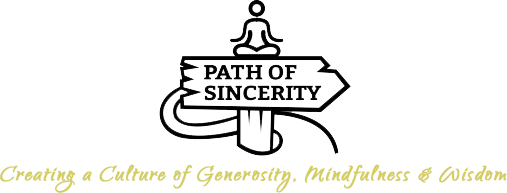
The following reflection originally appeared in the newsletter I sent out on July 7th, 2022.
———–
The Pain in Your Heart
Over the last few months, I’ve noticed a lot of twinges of pain in my heart.
I came back from a retreat and noticed gas prices went up .50 cents a gallon while I was gone. I open the news and read about any number of the latest Supreme Court rulings. I hear about another mass shooting (and then another one). I go onto social media and am reminded of the intense political polarization in the US. And there’s the ongoing wars in Myanmar and Ukraine. The economic collapse in Sri Lanka. Rampant poverty and racism, seemingly everywhere. Ugh.
On any given day, hearing about the above may take form in my body & mind as fear, anger, sadness, or the wish for something to be different. Or, to put it more simply, I sometimes feel a pain in my heart.
Of course, then there are all the personal pains we run into from time to time. A friend doesn’t return a text message. We say something that doesn’t land and we feel remorse or embarrassment. Our pet has diarrhea. We get a poor night of sleep. We get laid off. We come face-to-face with discrimination, oppression, or cruelty. And then there are the universal pains that visit us sooner or later, like those the Buddha spoke of in his 1st Noble Truth — aging, illness, loss, and death.
Whether its societal or personal, being a human in today’s world is filled with heartaches.
Early on in my practice, I told a spiritual teacher I was becoming more and more aware of all these heartaches and it was a little overwhelming. He replied that from another angle, this was actually a good thing, because it meant I was becoming more sensitive to what is. And, if I wished to create inner or outer transformation, it has its root in my ability to be present with what is.
How to Work with This Pain in the Heart?
For starters, it’s essential to be gentle with ourselves. It’s hard to be with pain! There’s no shame in having a hard time with it, even if you’ve been working on this mindful thing for a long time. When in doubt, be gentle with yourself!
Entering a more investigative mode, it’s helpful to notice our conditioned reactions to pain — especially the ways we struggle to be with what is. For example, do we tend to become overwhelmed by intense emotions or thoughts, and spiral into a funk? Or, perhaps, we tend to become numb, indifferent or avoidant? Whatever tendencies we notice, we become sensitive to that too.
Having a little more wherewithal of our patterns (and self-gentleness), the timeless practice is simply to feel the pain. For example, I recently heard news that my friend’s cat was killed by a coyote on the outskirts of the city. In the moment I heard the news, a little twinge of pain struck my heart and I did the following:
1. Soften my muscles (noticing the tendency to contract them amidst pain).
2. Feel the feeling in my heart (dropping away the resistance).
3. Not let the thoughts take over (just feeling the feeling in my heart).
On one level, it’s really that simple.
When we can engage with the heartaches of life without resistance and without letting the thoughts run the show, we’re able to truly be with what is. We don’t spiral into a funk. We don’t feel overwhelmed. And, from this ground, compassion, equanimity, and discerning action (or inaction) are the natural byproducts.
A Few Potential Pitfalls of Working with Heart Pain
- If the feelings ARE overwhelming, one great practice to learn is titration, where we develop the ability to moderate how much we feel the difficult feelings. Like entering into a cold ocean, we learn to dip our toes in a little at a time, until we get fully acclimated. Here’s a short article on this practice and also a guided meditation.
.
This skill is especially important if you find yourself easily disregulated or have a history of trauma. Feeling the feelings when they just create disregulation is a bad strategy: instead, learn the skill of titration, and slowly slowly over the course of years, build up your meditation practice. Eventually, they will stop being overwhelming/disregulating.
. - While it’s true that it’s not so skillful to be avoidant and numb to what’s happening, the primary thrust of this is to not avoid YOUR OWN EXPERIENCE. In other words, if you’re feeling anxious or angry or afraid, you don’t want to avoid those feelings and not pretend like you don’t feel them. However, when I share this instruction about not avoiding, people sometimes think that this means they should read all the news and be informed of all the latest headlines, and if they’re not, then they’re in avoidance.
.
Here, consider the middle way — neither being totally aloof nor totally consumed. Monitor your own mind and the impact of taking in information. Maybe pulling away would be skillful. Maybe being a little more informed would be skillful. Maybe that changes over time. It doesn’t matter if you know all the things; instead, it matters more how you’re managing your own mind and showing up in the world.
.
- With both societal and personal heartaches, the human mind typically wants to jump right into “fixing it.” However, the point I’m trying to make today is that the first & most essential step is learning to be with your inner reality — to really feel it and be present with it. From there, we are able to reflect on the difficulty from a more grounded place. Instead of reactively going into some behavior that doesn’t even truly help, we can reflect more deeply on a skillful course of action.
.
Sometimes the answers that come to us may seem a bit unconventional, like for me, teaching the dharma & embodying a life of ethics, mindfulness and kindness, is actually a powerful answer to many societal heartaches, even though meditation and, say, war, may seem like very different things. Other times, the answers on what to do will be straightforward, like reaching out to a struggling friend. And yet other times, inaction may actually be the most skillful route, like just not engaging with the difficult co-worker who is always trying to create trouble.
A Couple of Tactical Points
1. Usually, it’s the thoughts that hijack our experience. For example, we hear the latest news about inflation and we feel a shot of fear. In and of itself, it’s just a little fear. However, the thoughts then jump into and weave wild stories about what could happen or what this means. Before we know it, we’re in a spiral! One mantra I like to use here is “out of the thoughts, into the body.” Likewise, keeping an eye on how quickly those thoughts can take over, and using whatever skills we have to not let them do so.
.
2. I strongly suggest taking on the mindset of not trying to “get rid of difficulty” or “overcoming it,” but rather taking on the mindset of “being-with.” Here is a great meditation I recorded for learning to “be-with.”
Conclusion
Being with heartache and pain is no fun; however, it doesn’t have to knock us over. Through developing a dedicated meditation practice, we become more and more able to meet life without overwhelm or escape — to be right here right now, fully greeting whatever is presented to us.
The simple instructions I’ve given above will be very helpful (i.e. feel your feelings). However, as this process can be a little slow-going, please please please remember to be gentle with yourself.
—————
If you would like to get a monthly’ish email with reflections like this one, along with some event updates, sign up here for the newsletter.
